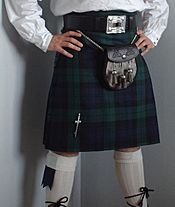Kilt facts for kids
A kilt is a ceremonial article of clothing worn in Scotland. It is made of a thick, woven fabric with a tartan (checkered) pattern. It resembles a pleated skirt except and was originally worn by men. It is still worn during ceremonies by some Scottish and Canadian military units and by people who play the bagpipes (a Scottish wind instrument). Although the kilt is most often worn on formal occasions and at Highland games and sports events, it has also been adapted as an item of informal male clothing in recent years, returning to its roots as an everyday garment. Particularly in North America, kilts are now made for casual wear in a variety of materials. It is also quite commonly worn by men at weddings.
Women of Scotland started to wear kilts in the 1800’s, this was most popular during highland dances. In the 1900’s kilts worn by women became so widespread (especially for highland dancing) that it generated public conversations about types of kilts that women should be allowed to wear, if at all. As result, the kilted skirt was introduced. It was similar in length and style to the men's kilt but gave women their own identity. Women of Scottish descent quickly adopted the kilted skirt.
It is first recorded in the 16th century as the great kilt, a full-length garment whose upper half could be worn as a cloak. The small kilt or modern kilt emerged in the 18th century, and is essentially the bottom half of the great kilt. Since the 19th century, it has become associated with the wider culture of Scotland, and more broadly with Gaelic or Celtic heritage. It is most often made of woollen cloth in a tartan pattern.
Today, kilted skirts are still popular, but women sometimes opt for a traditional style kilt if they wish to. For example, female members of pipe bands wear kilts that are visually no different from the men's kilts. Kilts have also been adopted as female wear for some sports.
Images for kids
-
General William Gordon, shown wearing a kilt - part of the uniform of the short-lived 105th Regiment of Foot - in the painting by Pompeo Batoni (1765–66).
See also
 In Spanish: Kilt para niños
In Spanish: Kilt para niños












